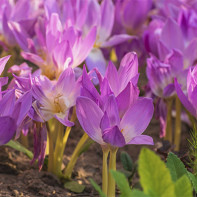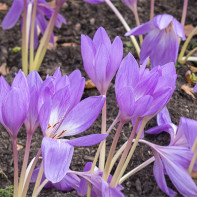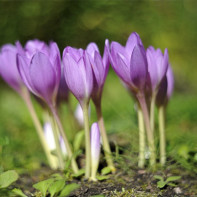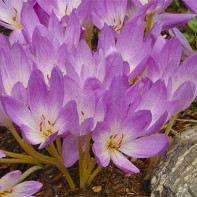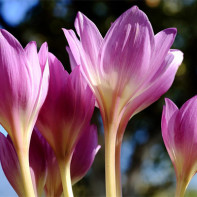Limpetpet flower: therapeutic properties and contraindications
Its beautiful name with a slight touch of romance the ageless flower was popular precisely because its flowers appear at unusual times for flowering - in simple terms, without time. It blooms in late fall, when all nature begins to die down, so its second folk name is the autumn flower. Botanists often call this perennial a colchicum, from the word Colchis. It is believed that this historical area on the eastern coast of the Black Sea was the home of the ageless flower.
- Chemical composition
- How it looks and where it grows
- Types
- Gathering and storage
- Therapeutic properties of the florescent of autumn
- Incremental in folk medicine
- Tincture for rheumatism and gout
- Tincture for arthritis and gout
- Tincture with vinegar for sciatica
- Tincture of the seeds for joints
- Tincture of fresh bulbs for cystitis
- Ointment for rheumatism
- Infusion for constipation
- Tincture for cancer
- Healing compositions
- Tincture
- Tincture
- Ointment
- Contraindications for use
- First aid in case of agelessness poisoning
Chemical Composition
The composition of the meadowfoil has been studied by scientists quite deeply, they found more than 20 alkaloids in the plant. These include colchicine and colchicine, which are similar in composition and have similar action, as well as colchicarin and speziosin, which are also relatives and which decompose to colchicine when heat treated. Colchicine and colchicine are essentially poisons, capable of inhibiting cell nucleus division and inhibiting cell reproduction. The plant is poisonous in its entirety, with especially many alkaloids in the leaves and seeds, making it impossible to use pastures because of their appearance among other grasses. Thus, a lethal dose of alkaloids is contained in only 6 grams of the seeds of the ageless flower. But it is because of its alkaloids that it is used in pharmacy.
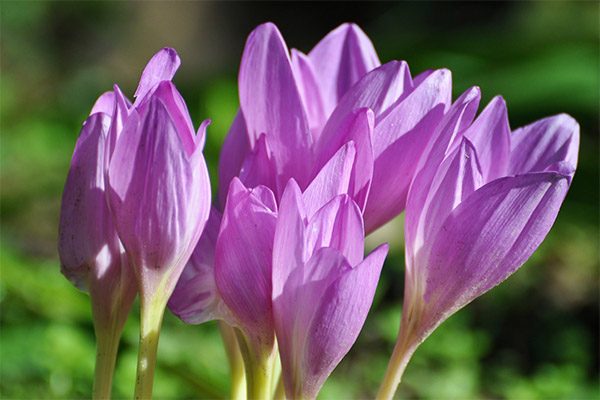
In addition to the alkaloid group of substances, the plant contains phytosterols that can reduce cholesterol and prevent cancer, as well as flavone apigenin, which has anti-inflammatory, antioxidant and anti-tumor effects. The seeds are rich in lipids, which replenish the body's energy needs and act as a natural barrier to protect cells. Components of the plant, such as resins, help to relieve inflammation, heal wounds, reduce pain, and increase the body's immune system. And tannins present in the ageless plant free the body from toxins and detoxes up to eliminate the effects of radiation exposure, stop the blood, protect against infection.
In addition, the plant contains a wide range of macro- and micronutrients in high concentrations: potassium, iron, calcium, zinc, copper, magnesium and selenium.
How it looks and where it grows
The ageless flower is a perennial bulbous herbaceous plant. Depending on the species and where it grows, it can be 20 cm high or stretch above half a meter - up to 60 cm. Its bulb is rather large, oval-shaped, it usually reaches 5-6 cm in length and a smaller diameter - from 3 to 4 cm. The bulb weighs about 40 g, with some outstanding specimens reaching 70-80 g.
The outside of the bulb is covered with dense, leathery, webbed, dark brown membranes that extend like a bell up to the stem and encircle the underside of the plant.
The leaves of the ageless plant usually range from four to six. They are fairly broad, oval-longish, with a neat rounded top. They reach 18-25 cm in length and vary in width: the upper ones are about 3.5 cm, the lower ones are larger and wider - about 7 cm. Each dark green shiny leaf is placed on a long sheath, which can be mistaken for a stem.
Large flowers appear in late fall, when the trees have long since dropped their leaves and the rhodiola itself has lost its leaves. It is not uncommon for them to grow already from under the first snow. The flower is formed in the place where the uppermost leaf was growing - right out of its axils. Plants in natural conditions have flowers of a pink and purplish-purple hue. In homesteads, the florifer grows with flowers of other colors - including white, yellow, and bluish.
From each bulb can appear from one to four flowers, shaped like a bell and a funnel at the same time. The upper edge of the "funnel" is divided into diverging petals, they are 5 to 6.5 cm long and 1.5 to 2.5 cm wide. Inside the corolla there are six stamens with large anthers, above which a fairly thick pistil rises. Despite the fact that it is autumn, the plant has time to be pollinated. When the ageless flower blossoms out, the corolla of the flower with the newly formed ovaries will droop and quietly winter, covered by a layer of dead leaves and snow. The temperature there is comfortable enough for the ovaries to slowly form and mature. And in late spring/early summer, round brown seeds 2-3 mm in diameter are ready to give life to a new plant.
The ageless flower is a light-loving plant of the subtropics. It grows in open places, preferring the moist, rich soils of meadows and deciduous forests of the southern latitudes of Europe. It is also comfortable in Asia, North Africa, the Mediterranean, as well as in the Caucasus Mountains, Krasnodar Territory, western Belarus, Lithuania and Ukraine.
Gardeners and flower growers have learned to grow ageless and in the middle belt, in many regions they grow even without additional shelter for the winter, like tulips.
Types
The ageless flower is a large genus of herbaceous plants, which includes almost more than 100 species. Many of them have become favorites of gardeners and flower growers and, despite their poisonous nature, actively populate the beds of private estates.
In Russia, two species grow in the wild - the autumn and the magnificent rambler. They grow in Krasnodar Krai, in its southwestern territories, from the foothills of the Caucasus up the slopes of the Caucasus Range to the subalpine belt.
The autumnal perennial.
It can be said that this is the most common, fitting all the classic descriptions of the ageless flower. Although it occurs in Russia, it prefers Europe - its moderately warm, moist meadows and glades of chestnut and hornbeam forests. It grows up to 40 cm in height.
Perennial merry-go-round.
This is the younger brother of the autumn one. It grows in limited areas - only in the lowlands of the Caucasus Mountains and in the lower reaches of the Don and Volga. Local steppes and meadows are its favorite habitat. This plant is slightly smaller than its progenitor, the rambler, so its bulb will not grow larger than 3 cm. But it is early-ripening: flowering in the fall, like all of its relatives, it bears fruit in April of the next year.
Incrembral splendid
It is also an endemic plant, found in a limited area. Its habitat is the Caucasus Mountains and Transcaucasia. It climbs the slopes up to a height of 3000 m. As it tolerates penumbra, it grows in meadows as well as in beech, hornbeam and chestnut forests.
Listed in the Red Book of the USSR back in 1988, and it is still forbidden to collect it.
This species was called magnificent for its regal beauty. It has long spectacular leaves of bright green color with a wavy edge. The flowers are striking even while still in bud - so beautiful because of their bright pink coloration. As they open, they show the inside of the calyx in paler pink or white.
The Cylicium immemorialum.
It also occurs in Russia, but gravitates to the Mediterranean coast of Turkey. There its main locations. It can grow up to 60 cm in height, its bulb is also large - 5 cm in diameter. It produces a huge number of flowers compared to the rest of the florals - up to 25 pieces.
Agrippa agrifolium.
Its second name is mottled. It probably came from the coloring of the flowers. They the plant has bright, pink-purple, with dark spots, like a chessboard. The stamens are not yellow like other plants, but orange. They can be admired only in Asia Minor.
Ankara, or three-leafed, may be called the Ancara perennial.
Although it is called Ankara, it has nothing to do with Ankara. In Turkey there are thickets of it, but not in the center of the country, where the city is, and in the west, along the coast. On the European part it grows in the mountains of Moldavia, in the steppes in the south-west of Ukraine, often found in Greece and Bulgaria, thus encircling the Black Sea and Aegean Sea. It grows on not very comfortable clay soils. Its height is no more than 15 cm.
This ageless flower is one of those species that blooms in spring rather than fall. And it has only three leaves, not more, which is reflected in its second name.
The dark purple agaricum.
A small plant - 10 to 15 cm in height. In September it begins to decorate nature with its flowers. When they just opened, the color is light purple, and after a couple of days gaining richness of tone and turn into a fuchsino-red. This type of plant is the closest relative of the Ankara bramble.
Bornmueller's ageless flower
It was named after the German botanist Josef Bornmüller, who as early as the 20s-30s of the last century made several expeditions to the Balkans and Greece and described many plant species, including the floricas.
This species is a resident of Iran and the mountains of Asia Minor. Its leaves grow to 30 cm in length and its pink-purple flowers have a large white spot inside the calyx.
The Byzantine bramble
Botanists suspect that this species is a close relative of the cilician rambler, from which it may have originated. Its flowers are larger than those of the autumn one, and the bulb is probably the largest, reaching a diameter of 7 cm. It has an irregular shape, which does not prevent it from producing about 12 flowers per flowering. The leaves of the plant are also special - wide, sometimes reaching 15 cm, as well as in the fold.
Flourless bunches
This species is distinguished by almost white and snow-white flowers, which are rare in nature. Usually such are bred by breeders for landscape design. They are collected in whole bundles - more than 20 pieces in each, hence the name. Flowering begins unusually - early spring.
The plant itself is short - from 10 to 20 cm, its leaves develop at the same time as the flowers.
Fomina immemorial.
Occurs only in Ukraine, in the Odessa area, as an endangered species was listed in the Red Book of the USSR and is still in the Red Book of Ukraine. It is an unsightly plant, 6 to 15 cm in height. Each bulb usually produces one flower, 2 or 3 are considered rare. It differs from the rest of the fall florals in that it blooms even in dry weather.
Water-loving flaxless.
Another Mediterranean Turkish resident. A small plant - up to 20 cm. It has a small round bulb about 2.5 cm. Refers to spring-flowering - flowers show as soon as the snow melts. Each bulb forms up to 8 delicate pink flowers.
The yellow evergreen
The most mysterious and inaccessible kind of plant. It settles very high in the mountains, near the glaciers, blooms at the same time as the snow melts. Although the plant is not tall, only 15 cm, and only 1 to 3 flowers are formed on each of them, they look stunning in this wild, almost lifeless place. Seeing them is a true gift for mountaineers climbing the Pamirs or Tien Shan, as well as conquering the mountains of India, Afghanistan or Pakistan.
Florists have bred many varieties and hybrids based on the florist's autumnal agar. And the main emphasis was on color. That is why there are so many white florals now in gardens, rare in the wild. They are both white with yellow in the middle, and the most beautifully machicolored, whose flowers can consist of 50 petals.
Gathering and storage
For harvesting as a medicinal raw material, the bulbs of the ageless flower are primarily suitable. They must be carefully dug out together with the roots, making sure not to cut or scratch them, because due to damage they quickly become covered with mold and rot. Do not tear off the roots either, they will fall off on their own when dry.
From the dug up bulbs carefully shake off the soil, but in no case do not wash - because of the water the raw material also quickly rots and spoils. Then spread out in the sun no more than 8-10 cm layer to dry out. Then put it away in a dry and cool, well ventilated room. Raw material can be stored no more than 3 months in glass containers with lapped corks, because the smell of finished raw materials is not very pleasant, although not pungent.
The best time for the raw material is when the mother lily of the valley is in bloom, from the end of August to the end of October. It is necessary to work with gloves and a mask, because all parts of the plant are extremely poisonous. Do not take bulbs less than 4 cm in length, they are not very rich in useful substances. You should remember that many species of agaricum are considered rare and endangered plants, and therefore included in the Red Book. So it is better to harvest the raw material on private farms.
But it is quite realistic to collect seeds: in fact, the plant itself remains safely growing and delighting others. The most suitable seeds are already formed, mature, having a brown color. By early summer, when the seed capsules reach the right condition, they should be cut and put to dry in the shade, in a well-ventilated place. After that, remove the seeds from them, which are stored in paper bags in a dry place.
Medicinal properties of the amau meringue
Official medicine uses preparations based on the flintlock in oncology due to the content of the alkaloid colchicine. It does not allow cancer cells to multiply and stimulates the process of their dissolution. These substances are especially effective against cancer pathologies of the thymus, prostate and pancreas, brain, liver, spleen, adrenal glands.
In addition, colchicine shows its anesthetic abilities. The alkaloid is eliminated from the body slowly, and due to this cumulative effect, its therapeutic effect lasts for a long time.
Earlier, scientific medicine had also allocated colchicine for the treatment of oncological pathologies, but now medics have abandoned it, because it is about 7-8 times more toxic than colchicine.
Colchicine in pill form is usually prescribed in combination with other anti-tumor drugs and is also used in ointment form for various skin cancers. In addition to its ability to fight cancer cells and relieve pain, it helps lower blood pressure and shortens the treatment of inflammation. Colchicine pharmaceuticals are prescribed for treatment only in a hospital, under the 24-hour supervision of a physician.
But not only for oncology, pharmacists produce preparations based on the ageless plant. Healing plant helps to cope with rheumatism, joint diseases, accelerates wound healing, for which it is used by dentists.
Liquid compositions - tinctures and infusions - have a diuretic effect, which is also used by official medicine. In a matter of a few receptions, such remedies are able to remove sand and stones from the kidneys and relieve edema.
The agaricum in folk medicine
The main thing is to observe the dosage in the most precise way. This plant is used as a laxative and diuretic, a choleretic and diaphoretic, an analgesic and a vomiting agent.
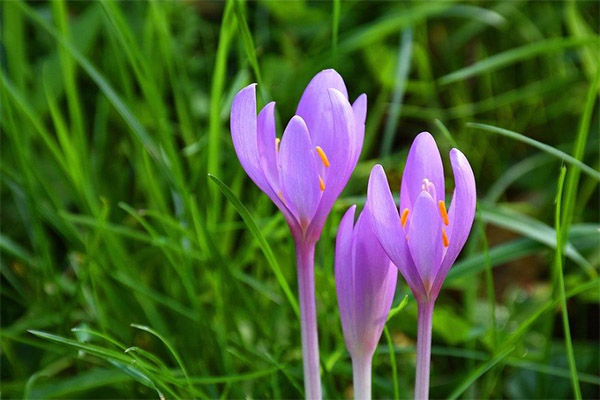
- Doctors since ancient times have coped with severe attacks of gout with St. John's wort, and now folk medicine continues this practice.
- Highly diluted aqueous infusion in small doses is used to heal whooping cough, dropsy, rheumatism, jaundice. It is recommended to get rid of bone aches during colds, treat cardiac weakness and neuralgia of various kinds.
- Alcoholic tincture prepared both on the bulbs and seeds is also a good remedy for gout, neuralgia, rheumatism and other joint problems.
Tincture for rheumatism and gout
An onion tincture is prepared for rubbing sore joints. Proportion is as follows: 1 part of raw material needs 5 parts of 50% alcohol. The drug is used in the form of a mixture of onions, onions, onions, onions, onions, onions, onions, onions, onions, onions, onions, onions, onions, onions, onions, onions, onions. Periodically shake the potion, at the end of the specified period, strain. Use for rubbing at gout and rheumatism.
Infusion for arthritis and gout.
This remedy is prepared with water, you need 500 ml of boiling water, which should be poured in a clay or porcelain dish half a teaspoon of dried and chopped onion. Insist for 2 hours, strain and squeeze the rest well. Start taking in drops, gradually increasing the dose, daily intake - 6 times. A maximum of one time you can drink 8 ml of water infusion. Drink the remedy with warm water, be sure to drink at least a glass of liquid. Infusion is recommended for the treatment of gout, arthritis, rheumatism and radiculitis. It is possible to combine internal reception with external application as a lotion.
Vinegar tincture for sciatica
From the perennial can be prepared a tincture in vinegar, which is then successfully used for pain relief for sciatica and osteochondrosis, rheumatism and arthritis. Take 12 parts of vinegar for 1 part of dry chopped bulbs of the plant. The herb is poured into a glass bottle, pour the vinegar, leave to infuse for 2 weeks and then strain. A teaspoon of the healing composition is enough to rub the sore spot.
Seed tincture for joints
Tincture on the seeds of the perennial can be used as an external remedy, as well as to drink in small doses. The effect will be the same - the aching joint and muscle pain will subside. For its preparation, you need to take 1 part of the seeds 10 parts of 70% alcohol. Mix them in a glass bottle and insist in a dark closet for 3 weeks. Shake the bottle from time to time. Strain and drink 15-20 drops three times a day regardless of meals. The maximum course of treatment is 2-3 weeks. If you decide to apply the remedy externally - rub it in the sore spot also no more than 3 times a day.
Tincture of fresh bulbs for cystitis
Those who suffer from cystitis, urolithiasis, edema in the morning, you can recommend a tincture of bulbs of the healing plant. You need to take 2 freshly dug bulbs. Put on gloves and gently rub the bulbs, pour a good vodka (200 ml). Insist 3 weeks in a dark visit, shaking occasionally. Take 3 times daily, no more than 2 drops at a time, drinking a glass of warm boiled water. To test how the body reacts to the ageless, the first time it is better to reduce the dose and take just a drop of the remedy, watching for at least half a day, whether there will be signs of poisoning or allergy.
Rheumatism ointment
All parts of the plant are suitable for making ointment. Leaves, bulbs and seeds should be taken in equal amounts. Mix and pour 200 ml of boiling water 3 tablespoons of the mixture of the medicinal plant. Boil the resulting infusion in a ladle on low heat until you get a gray viscous mass. Mix the hot mass with vegetable oil in a ratio of 1:1. As it cools, you can begin to apply it to lubricate sick joints before bedtime. For one treatment is enough for a third of a teaspoon of ointment. It is not necessary to increase the dose. The remedy soothes joint pain in rheumatism, arthrosis, osteochondrosis.
Infusion for constipation
Crush the seeds of motherless, take half a teaspoon of raw materials and pour half a liter of boiling water. Wrap well and leave to infuse for 3 hours. Take after straining, a portion - half teaspoonfuls infused with a glass of boiled water. The daily rate - 4 doses. Remedy mends bowel activity in constipation. Use in rare cases, make the composition a means of daily use can not.
Tincture for cancer
To alleviate the pain of cancer, take 10 g of the seeds of the medicinal plant and pour 120 ml of medical alcohol. Insist for 3 weeks. After straining, take a drop in the morning, lunch and evening. If the pain is unbearable, you can take 2 drops. Drink the tincture with warm water.
Types of healing compositions
Folk medicine uses remedies from the flintlock as a diuretic, laxative, analgesic and vomiting. The plant is highly poisonous, so you can prepare healing solutions at home only with gloves and precautions. Children at this time, it is better to take them away for a walk, so they inadvertently do not grab the cuttings or fragments of the plant.
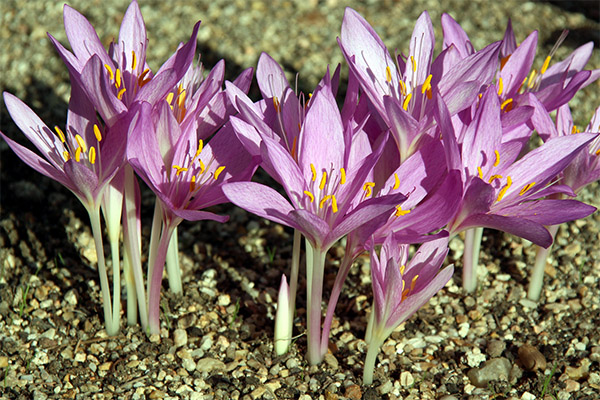
Infusion
Infusion of St. John's wort is prepared with plain water and then used to reduce edema in dropsy, treat whooping cough and jaundice, as well as apply its analgesic abilities when the bones ache with colds and flu, arthritis and rheumatism. The remedy improves the condition of the patient with pain of a neuralgic nature, radiculitis, as well as with heart weakness.
To prepare an infusion of the healing plant, you need to take half a teaspoon of chopped dry onion and, pouring it 500 ml of boiling water, insist for 2 hours. After straining, the composition should be used for ingestion.
Tincture .
If you take alcohol or vodka to make a tincture, the rules of infusion are the same for different therapeutic purposes: pour the medicinal raw material with the liquid in a glass or porcelain dish. It is more convenient, of course, in a bottle of dark glass, because during the infusion the composition must be shaken daily. The process of infusion should take place at room temperature in a room where the remedy will not reach the rays of light, you can just put it in a dark closet. The finished liquid should be stored in the refrigerator. It is important not to forget to wash down the tincture with a glass of warm boiled water when applying it internally.
For internal use from a fresh onion
It is not necessary to wait until autumn to procure onions and make medicinal remedies from them, in case of acute need, you can dig them up in the summer. Fresh onion or grate or very finely chopped, pour 100 ml of quality vodka and insist 3 weeks in a glass container in a dark room, shaking regularly. Strain and take for gout, neuralgia, pain in the joints a drop a day. Do not use more than two weeks without a doctor's supervision.
For pain relief
Pour medical alcohol over the dried and crushed bulbs of St. John's wort. Take 5 times as much liquid as the raw material. Infuse for 15 days and use in two ways to alleviate the pain of rheumatic nature. You can take 1-2 drops by mouth before going to bed or rub the sore spots.
Diuretic
Dry bulbs can not be ground but simply crushed and pour them in 200 ml of good quality vodka. Infuse for 2 weeks, strain and drink 2 drops in the morning and evening for edema, cystitis, stones or sand in the kidneys.
Seed tincture for pain relief
Such a tincture is effective both when taken internally and for external use. For its preparation, you need to take 100 grams of seeds and half a glass of medical alcohol. Seeds a little crush, pour into a container with alcohol and shake to mix better. Insist for 3 weeks, strain and take a drop a day. You can rub the healing composition sick elbows, knees, lower back, if aching joints. It is important not to exceed the dose, enough half a tablespoon per rubbing.
Ointment
To make an ointment at home, you need to crush 3 bulbs of mother lily of the valley (300 g), you can replace part of it with finely chopped leaves. Medicinal raw materials pour water (2 cups) and send to a water bath. Boil the composition for at least 30 minutes, remove, after cooling, strain and mix with petroleum jelly.
If petroleum jelly is not available, also butter to a creamy consistency will do. Store the homemade ointment should be in the refrigerator, covered with a secure tight lid. The composition is used to relieve pain in exacerbations of arthritis, rheumatism, radiculitis or gout. Smear the ointment on the sore spot once a day, for the procedure is recommended to take no more than a third of a teaspoon of healing agent.
Contraindications for use
Considering that the perennial is poisonous, everyone without exception should take it seriously, and before using compositions based on the healing plant, you must consult with your doctor and follow all his recommendations exactly. If in connection with the decision to treat bezrennik will need additional examinations before or during the course of admission, it is necessary to pass all of them and take the necessary tests. The fact is that the active substance colchicine in excessive doses can provoke leukopenia - that is, disruption of the mechanism of hematopoiesis, as well as cause a number of other side effects. Therefore, it is categorically contraindicated to pregnant women, people suffering from renal or hepatic failure, bone marrow problems, purulent diseases.
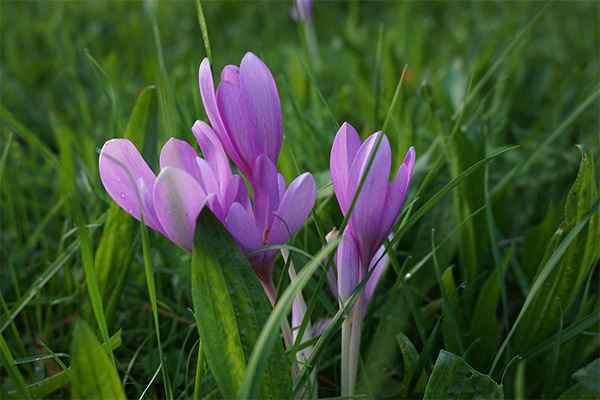
For the same reason, the ointment from this medicinal plant should not be applied close to the organs lined with mucous membranes - eyelids, mouth, rectum. The mucous membranes absorb colchicine much faster than the skin.
It is contraindicated for diarrhea, because it itself provokes diarrhea, as well as for such a disease as diarrhea, because it is a diuretic.
Do not prescribe compositions of this medicinal plant to patients who have received as a result of any disease such a serious complication as neutropenia, in which the body rapidly reduces the number of neutrophils, which play an important role in the destruction of pathological microorganisms.
If there is the slightest suspicion of internal bleeding - tar-like stools or an admixture of blood in the vomit - ageless flax is also prohibited.
First Aid for Breastfeeding Poisoning
In case of overdose and poisoning with flintless, first a burning in the throat, then - nausea and vomiting, and strong, containing bile, gastric mucus and even blood. The stomach and oral cavity are severely painful. The stools become very thin and have an unpleasant, pungent odor. The person is constantly thirsty, his face becomes pale, and his lips turn blue. Mucus may appear on the skin.
The pulse becomes very irregular, fast and slow. Tachycardia changes to bradycardia as blood pressure falls. The picture of heart disturbance is accompanied by pain behind the sternum. Unless urgent action is taken, the case may end in convulsions, paralysis and respiratory tract spasm.
Such symptoms are characteristic both for poisoning during treatment, if the recommended dosage of the drug is exceeded, and if the safety rules for the care of the plant or the preparation of medicinal raw materials are not followed. In the second case, of course, the clinical picture will not be as bright. But the help of a doctor in any case is required immediately. The second-third day after poisoning is considered the most dangerous. If the patient is left without medical help, his internal organs may start to fail.
While the ambulance is on its way, you can take a capsule of sorbex or several tablets of activated charcoal (one tablet per kilogram of weight of the poisoned person) and then flush the stomach with a pale pink solution of manganese solution. You should also drink plenty of plain boiled water or milk before the doctor arrives.
The picture of poisoning develops slowly, it is stretched over several days, so it is important not to let the situation go on its own. Medics will take all measures to rescue and prescribe treatment, administer solutions of sodium chloride (saline) and glucose. If there will be respiratory disorders - will appoint oxygen.
But you must remember that there is no antidote to the poisons of the agrowfly. Treatment will be aimed at relieving the symptoms of poisoning. And if the poisoning was strong, the patient was left without medical care for a long time, then in the process of recovery may be another sign - hair loss.
«Important: All information on this site is provided solely for introductory purposes only. Consult a specialist before applying any recommendations. specialist before using any of the recommendations. Neither the editors nor the authors shall be liable for any possible harm caused by materials."

